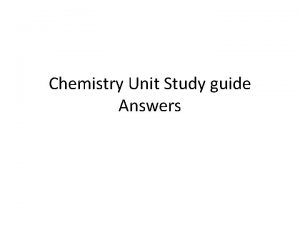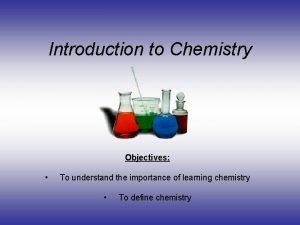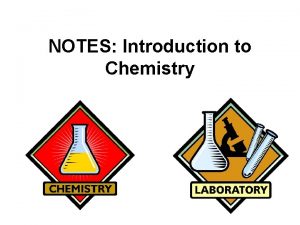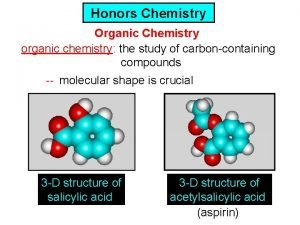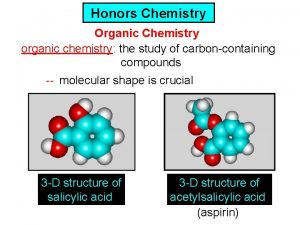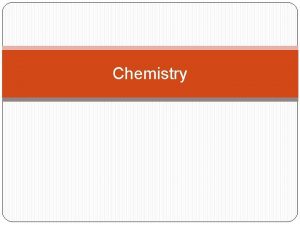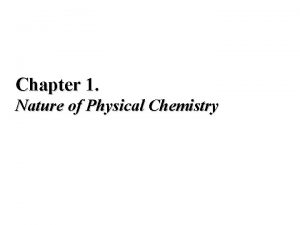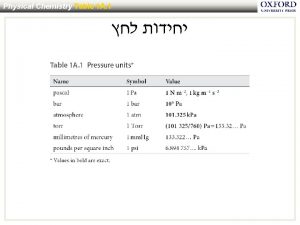PHYSICAL SCIENCE Introduction Physical Science CHEMISTRY Study of

















- Slides: 17

PHYSICAL SCIENCE Introduction

Physical Science • CHEMISTRY – Study of matter • PHYSICS • Study of matter & energy relationships

MATTER • All matter has volume and mass Amount of space taken up Amount of matter present

VOLUME • Measuring volume depends on the state of matter SOLID LIQUID -Measure volume in a graduated cylinder -SI unit = liter -Read the bottom of the meniscus -Regularly shaped, use lxwxh Units= cm 3 - Irregularly shaped, use water displacement To compare vol, 1 ml = 1 cm 3 GAS - Volume equals the volume of the container

VOLUME • Which is the best device to measure the volume of a liquid? Why?

VOLUME • Practice reading graduated cylinders – The marks, or calibrations, are different numbers on different graduated cylinders • http: //jchemed. chem. wisc. edu/JCEsoft/Progra ms/Video. CD/CPL/Sample/Modules/gradcyl/gr ad 10 m. L. htm

MASS • To measure the amount of matter present use a BALANCE – Triple beam vs. digital • Tare button- allows measurement of only the contents of a container • Units on balances are grams – Gram is about equal to the mass of a paper clip • SI unit is a kilogram – 1 kg= 2. 2 lbs

Changes in Mass? • Can an object change mass? How?

WEIGHT • Related to mass, but differs • It’s a measure of the force of gravity on matter • Gravity is a force of attraction between two objects – All objects in the universe have gravitational forces on other objects – The more matter, the higher the force of gravity So the higher the weight

WEIGHT • Measured using a spring scale • Units are Newtons (N) • Would you have the same weight on the Earth as on other planets? Why? • Would you have the same mass on the Earth as on other planets? Why?

Wrap-up section 1 • • • 1. 2. 3. 4. Complete “Lab Measurements” Go over DRW 2 -1 Frayer Model of Physical properties Chemical properties Physical changes Chemical changes


• Discuss frayer models of 1. Physical properties 2. Chemical properties 3. Physical changes 4. Chemical changes Chem/Phy Prop 1. Vol 2. Flammability 3. Malleability 4. Ductile • Do “Mystery Powders” Lab • Introduce DENSITY What do we already know?

Density Which weighs more a pound of feathers or a pound of lead? If the red spheres have the same mass, which cube weighs more? Why? Weight and density are different!!

Computing Density • D=m/v or Cover the variable that you are solving for and the correct formula is revealed!

Computing Density • Units? Sample problems 1. If the density of Al is 2. 70 g/cm 3, what mass would 5. 0 cm 3 have? 2. What volume would 10. 0 g of Al occupy? 3. What is the density of a 120. 0 g block that occupies 6. 0 cm 3?

Density lab Name of solid Mass of solid Add the information in red to your handout. Volume of liquid or formula for volume of solid Volume of liquid + solid or substitution in volume formula Volume of solid Formula to find density Substitution of values into the density formula Density of the solid
 Physical science final exam study guide
Physical science final exam study guide Physical science eoc study guide
Physical science eoc study guide Ib chemistry functional groups
Ib chemistry functional groups Inorganic vs organic chemistry
Inorganic vs organic chemistry Science fusion digital lessons
Science fusion digital lessons Branch of natural science
Branch of natural science Natural science vs physical science
Natural science vs physical science What is your favorite science subject
What is your favorite science subject Chemistry unit 1 study guide
Chemistry unit 1 study guide Chapter 10 study guide the mole
Chapter 10 study guide the mole Chapter 11 study guide stoichiometry
Chapter 11 study guide stoichiometry Chemistry
Chemistry Chemistry semester exam study guide
Chemistry semester exam study guide Vce biology poster
Vce biology poster Introduction to clinical laboratory
Introduction to clinical laboratory What is pharmaceutical inorganic chemistry
What is pharmaceutical inorganic chemistry Intro to organic chemistry
Intro to organic chemistry Introduction to chemistry
Introduction to chemistry








